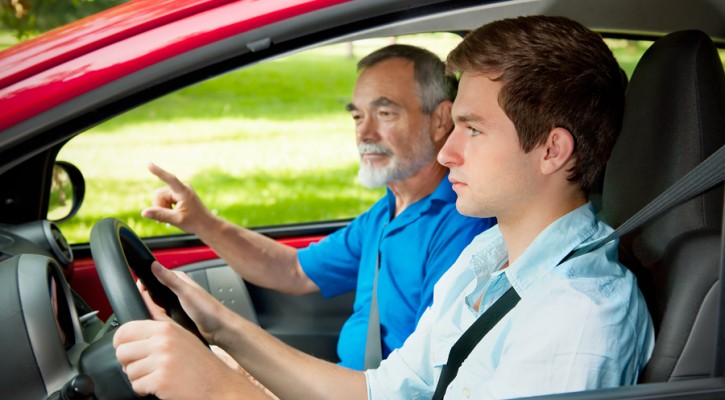Tag Archive: defensive driving

Driver Education: Why New Drivers Should Take a Defensive Driving Class
May 27, 2009
Though teens receive driver training prior to being licensed and are subject to Graduated Driver Licensing laws to protect them from statistically high-risk driving situations, training shouldn’t end when teens get their licenses. Reasons for this include:
1. Newly licensed teenage drivers are often giddy with newly acquired freedom. They will assimilate more information once they have become accustomed to the increased level of independence they’ve earned.
2. Teens may pick up bad driving habits, such as carelessness and recklessness, from riding with other teens.
3. Teens who received defensive driving lessons prior to gaining driving experience often have difficulty applying those lessons until they are licensed.
4. New drivers often suffer from information overload; spreading driver training lessons out over time means they will retain more in the long run.
5. Though drivers are statistically less likely to be injured or killed in motor vehicle crashes as they leave their teens, the overall risk remains high throughout the teenage years when compared to other age groups.
Taking a defensive driving course six to twelve months after licensure is very helpful for new drivers. Teens can take the course online or in a classroom. Typical topics include:
- Crash statistics and the physics of vehicle crashes
- Crash prevention techniques
- Occupant protection devices (such as seat belts and airbags)
- Driving under the influence of alcohol
- How to share the road with large trucks, motorcyclists, and pedestrians
- Dealing with stress and drowsiness while driving
- The hazards of speeding
- An overview of traffic laws in your state
When teens take a defensive driving class, they have the opportunity to apply concepts that may have seemed abstract prior to licensure. For example, crash prevention techniques are easier to appreciate once the driver has experience in maneuvering a vehicle; unlicensed teens are unlikely to understand how much stress and sleepiness negatively impact their driving abilities. However, as newly licensed drivers, teens haven’t been driving long enough to have ingrained driving habits, so they still have an opportunity to eliminate unsafe practices and become safe drivers.

Driver Education: Teens and Defensive Driving
May 20, 2009
Teens are often urged to “drive defensively.” This is an excellent suggestion for any driver and is of particular importance to new drivers, who have limited experience in dealing with emergency situations and who are developing driving habits they may have for the rest of their lives. But what is defensive driving, exactly?
Driving defensively means driving in such a way that you reduce the risk of a crash, which will in turn prevent injury to yourself and others. It means going beyond following the rules of the road to put safety first. For example, if another driver is supposed to yield the right-of-way to you but fails to do so, as a defensive driver you will yield the right-of-way to that driver to avoid a collision.
Defensive driving isn’t just important in emergency situations, however. Using defensive driving techniques will help you:
- manage stressful driving conditions
- avoid traffic tickets
- keep your vehicle in good mechanical condition
- keep your driver’s license
There is no doubt that driving can be stressful, especially when traffic is heavy. One element of defensive driving is to maintain an adequate following distance from the vehicle in front of you. This decreases the risk of a rear-end collision if the vehicle ahead stops suddenly. Other ways to manage stress by driving defensively include:
- driving at a speed that is appropriate for conditions (which may be lower than, but is never higher than, the posted speed limit)
- checking intersections for cross traffic when you have a green traffic light (in case another driver runs the red light or a pedestrian is in the crosswalk)
- keeping a space cushion on all sides of your vehicle so you have room to maneuver if necessary
- watching the road ahead of your vehicle and checking your mirrors every three to five seconds so you notice hazards before they become a problem
Avoiding traffic tickets is especially important to drivers who are subject to a Graduated Driver’s Licensing program; these programs often restrict advancement to the next stage of licensure unless very few or no points accrue on the teen’s license. Traffic violations also mean hefty insurance increases for young drivers, who are already paying high rates because they are in a high-risk category. But following the rules of the road only when you’re worried about getting a ticket is not sufficient; if you’re not concentrating on driving defensively, you’re likely to make mistakes due to your reduced level of alertness. These mistakes could result in a ticket or even a crash, and even a minor fender-bender can result in points on your driving record.
Part of defensive driving is making sure that your vehicle is in good mechanical condition. Don’t wait for a breakdown to get your vehicle checked out; your owner’s manual offers a schedule of suggested maintenance tasks. Tires with low air or worn tread reduce your traction and make skids more likely. Your brakes need to be in top condition at all times. Even something as simple as not having windshield wiper fluid in the reservoir can impair your visibility and increase your chances of a crash. Don’t just put gas in the car and drive; take responsibility for ensuring that your vehicle is ready for the road.
As you’ve probably learned from your driver handbook, having a driver’s license is a privilege, not a right. This means that your driver’s license can be taken away, including for some non-driving offenses.
Driving defensively is part of an overall pattern of responsible behavior that will help you keep your license and the increased level of independence that comes with it.
